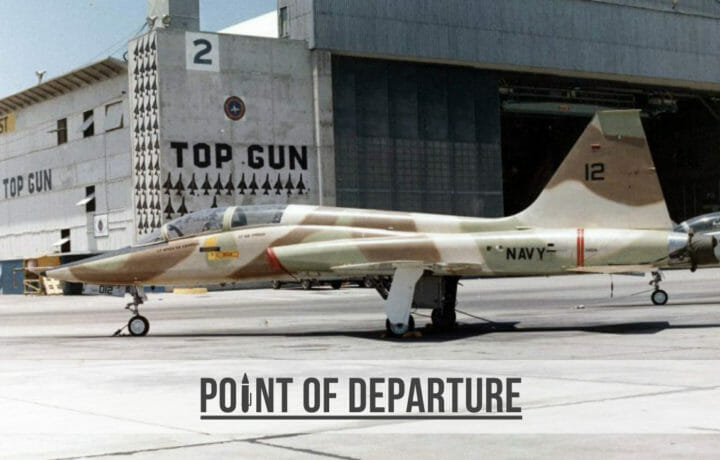“You can be my wingman anytime.”—Tom “Iceman” Kazansky
Thirty-five years. That’s how long it’s been since Top Gun splashed across movie screens and introduced audiences to the complicated, often dramatic, and hyper-masculine world of Navy Lieutenant Pete Mitchell, forever known to fans simply as Maverick, his all-too-appropriate callsign. The film debuted in the halcyon days before Tailhook, when glorifying the outrageous antics of fighter pilots seemed a little less controversial.
But, despite the ham-fisted approach to storytelling so typical of 80s action movies, the film’s appeal has endured. And, unlike other film franchises of the era, Top Gun didn’t launch into a series of progressively worse sequels, instead waiting—you guessed it—35 years to debut a sequel: the much-anticipated Top Gun: Maverick. So, what is Top Gun’s lasting appeal? Why all the nostalgia for a movie that might otherwise be forgettable?
Because the film is a classic. The soundtrack is phenomenal, with artists and songs that top any playlist of the period. The cast featured some of the best talent of the time and starred an actor who has been a box office favorite for decades. And the action sequences provided the Navy with a recruiting boost that remains the stuff of legend. But what makes the film a classic is the story itself. Ham-fisted or not, the storytelling is superb and resonates with a movie audience hungry for a little more than another rambunctious romp with Rambo or a temperamental teenager who somehow knows how to fly an F-15.
5 Life Lessons from Top Gun
On the surface, Top Gun was the premier military action film of the 80s. It had the flash, the swagger, and the machismo. It had the technology, the violence, and the breathtaking supersonic air combat sequences. But, beneath it all, was a great story. The kind of story that resonates with audiences subtly, in an almost imperceptible way. The film conveyed important life lessons that left a lasting impression, whether audiences realized it or not. Like the film itself, those lessons have endured over the decades. Even when the story seems a bit ham-fisted in retrospect.
1. It’s about redemption.
Maverick’s “family name ain’t the best in the Navy.” His own career has been, at best, “hit and miss.” He’s “one hell of an instinctive pilot” but “his ego is writing checks his body can’t cash.” In short, Pete Mitchell is the living embodiment of his own callsign, and that ensures success for him is always going to be elusive. Redemption for Maverick isn’t about a trophy or a plaque on a wall, it’s about—to borrow a phrase from Army recruiting—being all you can be, the very best version of you. And that’s where Pete Mitchell finds redemption.
2. It’s about loyalty and trust.
Everything about Pete “Maverick” Mitchell screams loner. From his callsign to the way he flies the Tomcat, Maverick’s only concern in life is, well… Maverick. But, if he’s going to be the “best of the best” and earn his place on the wall at Miramar, he’s going to have to learn to be part of a team. And that means demonstrating loyalty to something—and someone—bigger than himself, and to build trust with others. That’s transformational, and that fuels the growth of Pete Mitchell that keeps audiences coming back for more 35 years after the film’s release.
3. It’s about living your best life.
For the past 35 years, I’ve been singing along with the Righteous Brothers’ You’ve Lost that Lovin’ Feelin’. I think a lot of us have. From probably the worst barroom cover of a song to a shirtless beach volleyball game to the “I feel the need” moment, Top Gun is a reminder that a life worth living is worth living your best life. That probably sounds a little Hallmark moment-ish, but it’s true. It brings to mind something Colin Powell once said: “Surround yourself with people who take their work seriously, but not themselves, those who work hard and play hard.” You only get one chance to live your life, so make it count.
4. It’s about mentoring.
Through all the action, all the drama, and all the tragedy, there was Commander Mike Metcalf, callsign Viper. Without Viper, there is no redemption for Pete Mitchell. There is no heroic ending. Maverick is a ship without an anchor, adrift at sea. Viper bridges the past—the incident that “disgraced” Duke Mitchell—to the future; he provides the anchor missing in Pete Mitchell’s life. His mentoring and calming influence—two things most of us seek in life—set Maverick on the path to redemption.
5. It’s about believing in yourself.
There is wide gulf between false bravado and truly believing in yourself. Throughout much of Top Gun, we see a Maverick riddled with self-doubt. Behind a mask of cockiness and confidence is a man haunted by his own—and his family’s—past. The film captures Maverick’s journey well: he wasn’t selected for Top Gun, he gained his seat when Cougar “lost it, turned in his wings;” his attitude is the greatest obstacle to his own success; and the loss of Goose—while trying to do the right thing—reveal the depth of self-doubt that haunts Pete Mitchell. In the film’s climactic scene, Maverick finally overcomes that doubt and gains a true sense of confidence in his abilities, himself, and his team. His road to redemption is complete.




